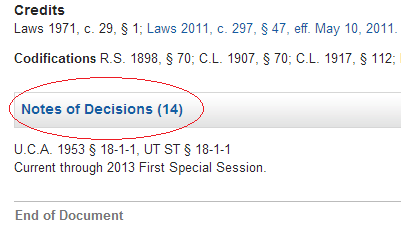In our first year legal research class, we’ve recently discussed statutory research. An annotated code is an extremely useful tool when doing statutory research because it provides references to cases and secondary sources that examine the code section you’re researching. Annotations can save a lot of time and provide a researcher with a lot of useful information.
WestlawNext presents annotations in a slightly different way than they are presented in print, Westlaw Classic, and Lexis Advance, so I find that it’s helpful to point this out to students so they know how to find this valuable tool in WestlawNext. In all other versions besides WestlawNext, annotation immediately follow the credits or history of the statutory section. So, when you look at a section, you will see the text and below that the annotations. In order to clean up the cluttered look this causes, WestlawNext hides the annotations from the original view, so as just to provide the statutory text and the credits. After the text and the credits, there is now a link that says “Notes of Decisions” that users can click on to find the annotations — the cases that reference the statutory section.
WestlawNext also provides tabs that have “Notes of Decisions” as well as “Context & Analysis,” which provides references to secondary sources that discuss the statutory section.
 All the annotations are still there, just in slightly different places with different names.
All the annotations are still there, just in slightly different places with different names.


